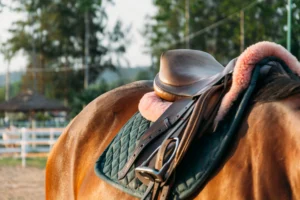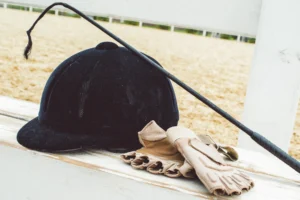Introduction
The Arabian horse stands as one of the most recognizable and beloved horse breeds in the world. With their distinctive dished faces, high tail carriage, and remarkable endurance, these horses have captivated equestrians for centuries. While their athletic abilities and refined appearance often take center stage, there’s another aspect of Arabian horses that deserves special attention: their stunning array of coat colors.
Arabian horse colors range from common variations like bay and chestnut to some truly extraordinary and rare combinations that might surprise even seasoned horse enthusiasts. In this comprehensive guide, we’ll explore both the classic and rare Arabian horse colors, delve into the fascinating genetics behind these coat variations, and showcase five jaw-dropping Arabian horse colors you may have never encountered before.
Whether you’re a long-time Arabian horse owner or simply an admirer of these magnificent animals, understanding the spectrum of Arabian horse coat colors adds another layer of appreciation for this ancient breed.
Understanding Arabian Horse Colors: The Basics
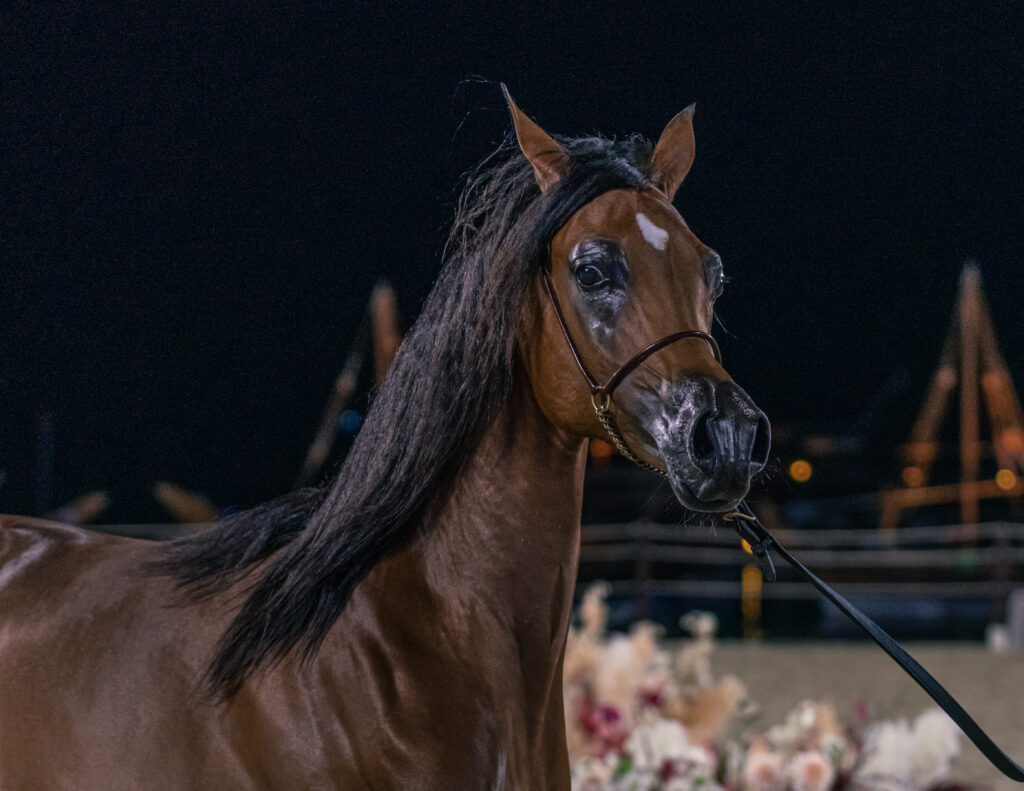
Before diving into the rarest and most spectacular Arabian horse colors, it’s important to establish a foundation of knowledge about the common coat variations found in the breed.
Common Arabian Horse Colors
Traditionally, Arabian horses appear in five primary coat colors, each with its own distinctive characteristics:
- Bay Arabian Horse: The bay Arabian horse features a reddish-brown body with black points (mane, tail, ear tips, and lower legs). This is one of the most prevalent Arabian horse colors, with variations ranging from light to dark bay.
- Black Arabian Horse: True black Arabians are relatively uncommon compared to other colors. These horses showcase a pure black coat without any brown areas, maintaining their color throughout the seasons.
- Chestnut Arabian Horse: Chestnut Arabian horses display coats in various shades of red, from light golden to deep liver chestnut. Their manes and tails typically match their body color or appear slightly lighter.
- Grey Arabian Horse: Technically not a base color but a progressive whitening gene, grey is extremely common in Arabian horses. Grey Arabians are born another color (often bay, black, or chestnut) and gradually lighten with age. Many eventually appear almost white, though they retain their dark skin pigmentation.
- White Arabian Horse: True white Arabians are exceedingly rare. These horses are born white and remain white throughout their lives, typically having pink skin underneath their coat, unlike the dark-skinned grey Arabian horse.
Arabian horse colors are controlled by specific genetic factors, with each foal inheriting color genes from both parents. This genetic diversity contributes to the wide range of color variations seen in purebred Arabian horses today.
The Genetics Behind Arabian Horse Color
Understanding Arabian horse color genetics helps explain both the common and rare color variations we see in the breed. Arabian horse color genetics involves several key genes that interact to create the various coat colors and patterns.
The base colors in Arabian horses are controlled by two main genes:
- Extension (E) gene: Determines whether black pigment appears in the coat
- Agouti (A) gene: Controls the distribution of black pigment
The interaction between these genes creates the three base colors found in Arabian horses:
- Bay (E/- A/-): Black pigment restricted to the points
- Black (E/- a/a): Unrestricted black pigment throughout the coat
- Chestnut (e/e): No black pigment, only red pigment
Additional genes modify these base colors, creating the full spectrum of Arabian horse coat colors. The most influential of these modifiers include:
- Grey (G) gene: Causes progressive whitening of the coat
- Dilution genes: Create color variations like cream, champagne, and pearl
- White spotting genes: Produce patterns like sabino and splash white
Arabian horse color genetics is a complex field, with new discoveries continuing to enhance our understanding of how these magnificent animals develop their distinctive coat colors.
5 Extraordinary Arabian Horse Colors You’ve Likely Never Seen
Now, let’s explore five truly exceptional Arabian horse colors that stand out for their rarity, beauty, and unique genetic characteristics. These Arabian horse colors represent some of the most fascinating variations within the breed.
1. Dominant White Arabian Horse
While the grey Arabian horse is common, truly dominant white Arabians represent one of the rarest Arabian horse coat colors. Unlike grey horses that progressively lighten with age, dominant white Arabians are born white and remain white throughout their lives.
The dominant white gene (W) causes a complete or nearly complete absence of pigment in the coat, resulting in a striking white appearance. These horses often have pink skin beneath their white coat and dark eyes, distinguishing them from the grey Arabian horse, which maintains dark skin despite its white appearance.
Dominant white is extremely rare in purebred Arabian horses, making these horses truly exceptional specimens. The genetic mutation responsible for dominant white can occur spontaneously, creating horses of remarkable beauty that often become highly valued in breeding programs focusing on unusual Arabian horse colors.

2. Sabino Arabian Horse
The sabino pattern represents one of the most eye-catching color variations in Arabian horses. This pattern falls under the category of white spotting patterns and creates a distinctive appearance characterized by:
- Irregular white patches, often with jagged edges
- White extending upward from the legs and belly
- White facial markings, frequently including a blaze
- Scattered white hairs or roaning throughout the coat
Sabino Arabian horses can have minimal white markings or extensive white areas covering much of their body. The most dramatic expression, known as “sabino-white,” can result in a horse that appears almost entirely white but genetically remains distinct from dominant white Arabians.
The sabino pattern has been present in Arabian horse bloodlines for centuries, though its genetic basis was only recently identified. Today, sabino represents one of the most sought-after unusual Arabian horse colors, prized for its striking visual appeal and genetic uniqueness.
3. Silver Bay Arabian Horse
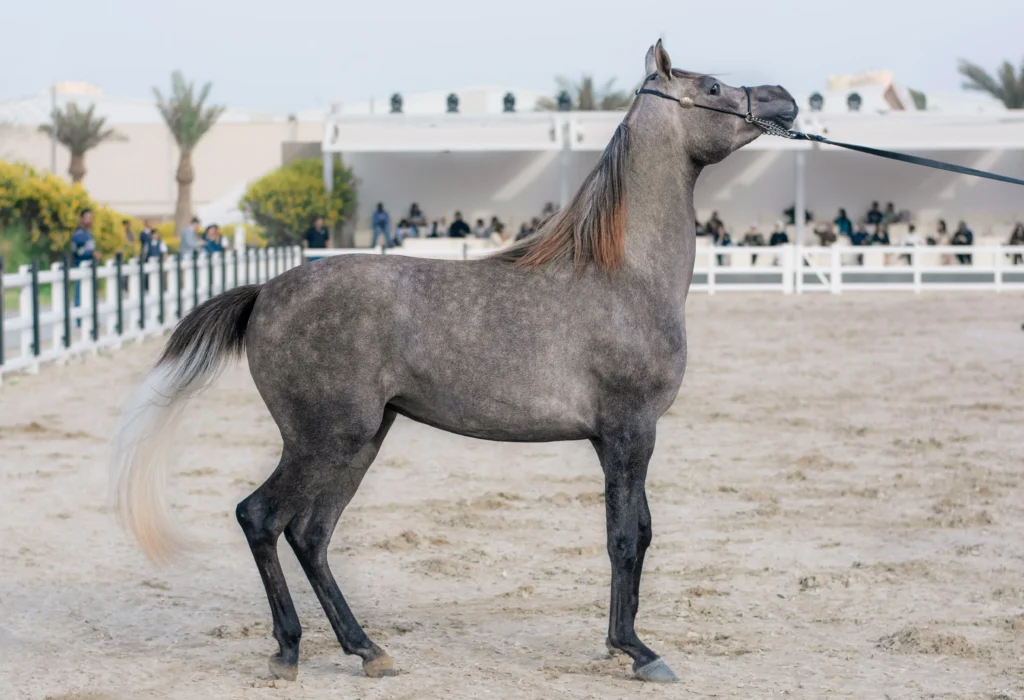
The silver bay Arabian horse presents a fascinating and rare color variation that dramatically alters the appearance of the traditional bay. This color results from the silver dapple gene, which lightens black pigment while leaving red pigment largely unaffected.
In silver bay Arabian horses, this genetic influence creates:
- A body color ranging from chocolate to taupe
- A flaxen or silver mane and tail, often with darker roots
- Lower legs that appear lighter than typical bay points
- Sometimes, subtle dappling across the coat
The silver dapple gene is extremely rare in purebred Arabian horses, making the silver bay Arabian horse one of the most uncommon color variations in the breed. This rarity contributes to their special status among Arabian horse color enthusiasts.
Some Arabian horse registries have documented silver bay individuals, though their unusual appearance sometimes leads to debates about color classification. For those seeking rare Arabian horse colors with scientific backing, the silver bay represents an intriguing color variation with distinctive genetic roots.
4. Splash White Arabian Horse
The splash white pattern creates one of the most distinctive Arabian horse color variations. This pattern gives the impression that the horse has been dipped in white paint, with clearly defined white areas primarily on the lower parts of the body.
Characteristic features of splash white Arabian horses include:
- Crisp, horizontally oriented white markings
- White that typically starts at the belly and legs
- Bold white facial markings, often including blue eyes
- A clear delineation between colored and white areas
Splash white is one of the rarest color patterns in purebred Arabian horses, with only a small number of confirmed cases. This scarcity makes splash white Arabians particularly valuable for breeders interested in unusual Arabian horse colors.
Recent genetic research has identified specific mutations responsible for the splash white pattern, allowing for more precise identification and breeding decisions. While splash white is more common in other breeds, its appearance in Arabian horses creates truly exceptional individuals that stand out from the typical Arabian horse color palette.
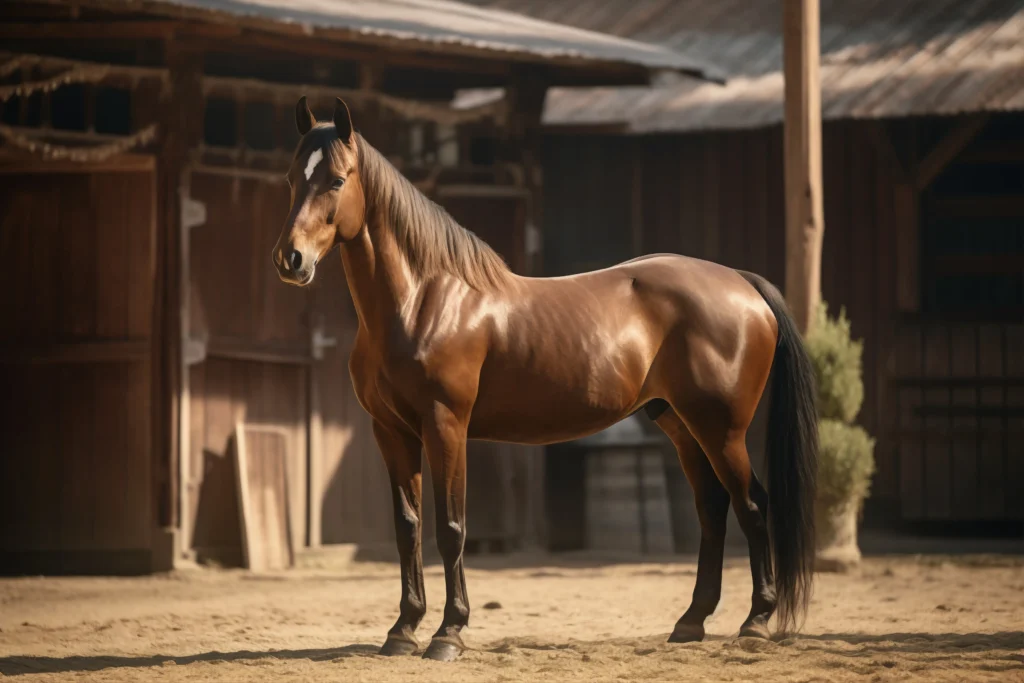
5. Rabicano Arabian Horse
The rabicano pattern represents one of the most subtle yet fascinating Arabian horse color variations. Often mistaken for roan, rabicano creates a distinctive appearance through scattered white hairs that follow a specific distribution pattern.
Key characteristics of rabicano Arabian horses include:
- White hairs concentrated at the flank and base of the tail
- A distinctive “coon tail” with white hairs at the tail root
- White ticking that may extend up the barrel
- Horizontal white markings sometimes visible on the ribs
The rabicano pattern can occur on any base Arabian horse color, creating variations like rabicano bay, rabicano black, or rabicano chestnut. The intensity varies dramatically between individuals, with some showing minimal white ticking and others displaying extensive white across their body.
Despite being present in Arabian horse bloodlines for generations, rabicano remains underrecognized compared to other color patterns. The genetic mechanism behind rabicano differs from both grey and roan, representing a unique contribution to the spectrum of Arabian horse coat colors.
Beyond the Basics: Arabian Horse Color Variations
While we’ve explored both common and rare Arabian horse colors, the full spectrum includes numerous variations that deserve mention. These color variations demonstrate the genetic diversity within the Arabian breed.
Dilute Colors in Arabian Horses
Dilution genes create some of the most attractive variations in Arabian horse colors. These genes lighten the base coat colors in specific ways:
Cream Dilution: While relatively uncommon in purebred Arabians, the cream gene can create:
- Palomino (one copy of cream on chestnut)
- Buckskin (one copy of cream on bay)
- Smoky black (one copy of cream on black)
- Cremello, perlino, or smoky cream (two copies of cream)
Champagne Dilution: Extremely rare in Arabians, this dilution lightens both the coat and skin pigment, often creating a metallic sheen.
Pearl Dilution: Another rare dilution that has minimal effect as a single copy but creates distinctive perlino-like colors when combined with cream.
Color Patterns in Arabian Horses
Beyond solid colors, Arabian horses can display various patterns that add visual complexity to their coats:
Flaxen: Particularly common in chestnut Arabian horses, flaxen creates a distinctively light mane and tail that contrasts with the body color.
Sooty: This pattern darkens areas of the coat, creating dramatic contrasts, especially on bay and chestnut Arabians.
Dappling: Most common in grey Arabian horses, dappling creates distinctive rings of lighter color across the coat.
Brindle: Extremely rare in Arabians, brindle creates vertical stripes of varying shades across the body.
Arabian Horse Markings
While not technically colors, white markings contribute significantly to each horse’s individual appearance:
Facial Markings: Including stars, stripes, blazes, and snips Leg Markings: From small coronet markings to high stockings Body Markings: Occasional white patches that don’t fall into specific pattern categories
These markings, combined with the underlying coat color, create the unique appearance of each Arabian horse.
Most Popular Arabian Horse Colors Today
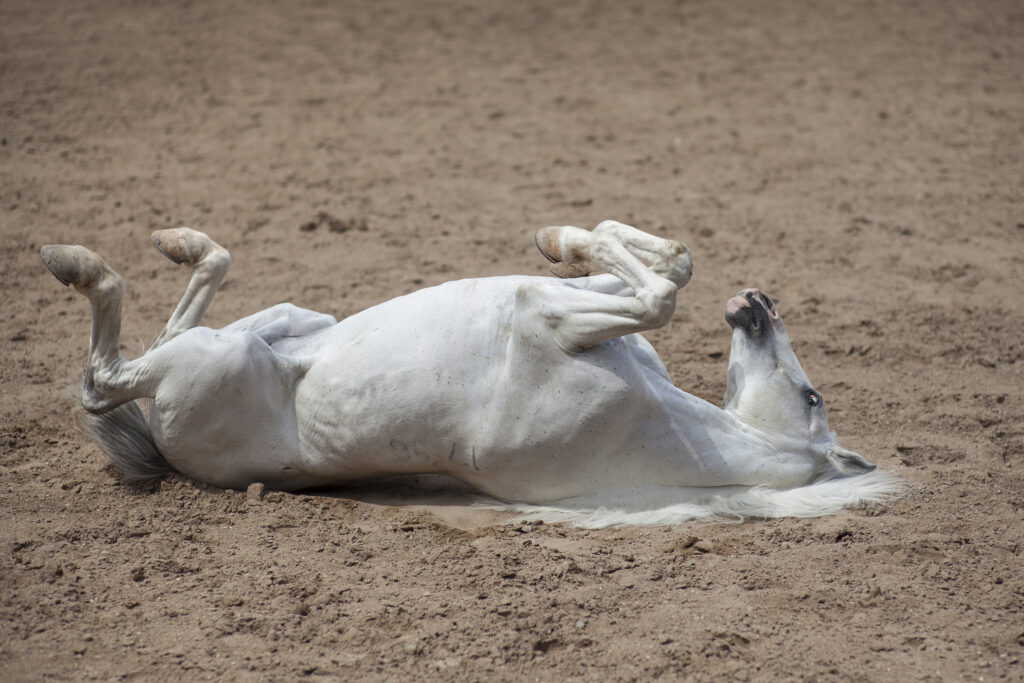
Among the wide range of Arabian horse colors, certain variations consistently rank as the most popular among breeders and enthusiasts:
- Grey Arabian Horse: The grey Arabian horse tops popularity charts worldwide. Their tendency to develop a nearly white coat while maintaining dark skin helps protect them from sunburn in their native desert environment. Grey Arabians often display beautiful dappling during the transition years, adding to their appeal.
- Bay Arabian Horse: The bay Arabian horse represents the quintessential color for many purists. With its rich reddish-brown coat and distinctive black points, the bay Arabian showcases the classic color that appears prominently in historical depictions of the breed.
- Chestnut Arabian Horse: The warm, golden-red tones of chestnut Arabian horses have captured hearts for generations. From light gold to deep liver chestnut, these horses display the fiery color that many associate with Arabian temperament.
- Black Arabian Horse: Though less common than bay or grey, the black Arabian horse holds special appeal for many enthusiasts. The contrast between their pure black coat and the traditional Arabian features creates a striking appearance that stands out in any setting.
- White or Near-White Arabian Horse: While true white is rare, aged grey Arabians that appear white remain extremely popular. Their snow-white appearance embodies the mystical quality often associated with Arabian horses in literature and art.
Preferences for Arabian horse colors vary by region, with certain colors gaining particular favor in specific geographic areas based on local tradition and breeding goals.
Historical Significance of Arabian Horse Colors
Throughout history, Arabian horse colors have carried cultural significance and practical importance. Traditional Arabian horse breeders paid careful attention to coat color, often for reasons beyond mere aesthetics.
In desert environments, certain Arabian horse colors provided practical advantages:
- Grey Arabian horses reflect more sunlight, helping them stay cooler in extreme heat
- The dark skin of grey Arabians protects against sunburn despite their light coat
- Bay Arabian horses with black points show less visible dust and dirt
Different Arabian horse colors also became associated with specific tribes and bloodlines, creating a rich tapestry of color preferences. Some historical accounts suggest that certain Arabian horse colors were favored for particular uses:
- Bay Arabians for warfare
- Grey Arabians for ceremonial purposes
- Chestnut Arabians for endurance
These historical associations continue to influence modern Arabian horse breeding, though performance and conformation now typically take precedence over color preferences.
Choosing an Arabian Horse: Should Color Matter?
When selecting an Arabian horse, coat color often influences buyers’ decisions, sometimes unconsciously. However, experienced horsemen generally recommend focusing on more substantial qualities:
- Conformation: The horse’s physical structure and adherence to breed standards
- Movement: Quality of gaits and natural way of going
- Temperament: Personality and trainability
- Health: Soundness and absence of genetic conditions
- Bloodlines: Ancestry and genetic potential
While Arabian horse colors contribute to the breed’s appeal, they should ideally represent a secondary consideration after these fundamental qualities. Nevertheless, certain color preferences remain strong among Arabian enthusiasts, and unusually colored Arabians often command premium prices.
For those specifically interested in rare Arabian horse colors, working with knowledgeable breeders who understand the genetics behind these variations becomes especially important. Such breeders can help identify horses that combine exceptional color with the traditional quality expected in purebred Arabian horses.
Future Trends in Arabian Horse Colors
As genetic testing becomes more sophisticated and accessible, we’re gaining deeper insights into Arabian horse color genetics. This scientific progress is influencing breeding practices and color preferences in several ways:
- Genetic Identification: Tests now identify carriers of rare color genes, even when the genes aren’t visibly expressed
- Preservation Efforts: Breeders are working to preserve rare Arabian horse colors through careful breeding programs
- New Color Combinations: Advanced understanding of color genetics allows for more precise breeding for specific color results
- Color Registration: Registries are improving documentation of Arabian horse colors based on genetic testing
These developments suggest that the future may hold even greater diversity in Arabian horse colors, with rare variations becoming more accessible through scientific breeding approaches.
Conclusion
The world of Arabian horse colors encompasses far more than the casual observer might initially perceive. From the classic bay Arabian horse to the exceedingly rare dominant white Arabian, these colors reflect both the breed’s ancient heritage and the fascinating genetic diversity that continues to evolve.
The five extraordinary colors we’ve explored—dominant white, sabino, silver bay, splash white, and rabicano—represent just a fraction of the potential color variations within purebred Arabian horses. Each variation adds to the breed’s mystique and appeal, giving enthusiasts new dimensions to appreciate beyond the Arabian’s legendary athletic abilities and distinctive profile.
Whether you’re drawn to the traditional Arabian horse coat colors or fascinated by the rarest color variations, understanding the genetics and history behind these colors enhances appreciation for these magnificent animals. As science continues to unravel the genetic mysteries behind Arabian horse colors, we can anticipate even more stunning variations in the future.
For those considering adding an Arabian horse to their stable, remember that while color creates the first impression, the qualities that have made this breed legendary for thousands of years—courage, intelligence, loyalty, and athletic ability—transcend any coat color. The true Arabian horse captivates not just with its appearance but with its incomparable spirit.
Resources for Further Learning
For those interested in exploring Arabian horse colors in greater depth, these resources provide valuable information:
- Arabian Horse Association Color & Markings Guide
- UC Davis Veterinary Genetics Laboratory
- The Equine Tapestry: Arabian Horse Colors
- The Arabian Horse Society of Australia
- World Arabian Horse Organization
Internal Links
Explore more about horses on our website:



